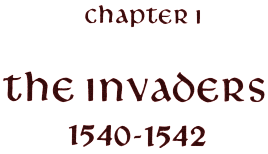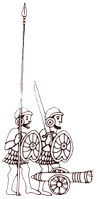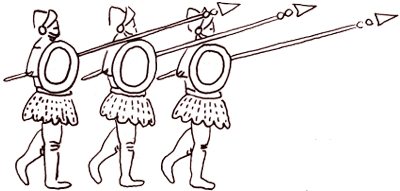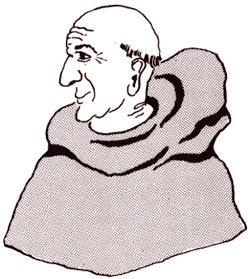

Contents Foreword Preface The Invaders 1540-1542 The New Mexico: Preliminaries to Conquest 1542-1595 Oñate's Disenchantment 1595-1617 The "Christianization" of Pecos 1617-1659 The Shadow of the Inquisition 1659-1680 Their Own Worst Enemies 1680-1704 Pecos and the Friars 1704-1794 Pecos, the Plains, and the Provincias Internas 1704-1794 Toward Extinction 1794-1840 Epilogue Abbreviations Notes Bibliography |
Cicuye Defies the Invaders
By their actions, the people of the eastern fortress-pueblo confirmed El Turco's story. When Capt. Tristán de Arellano, in command of the main army returning from the plains, had approached Cicuye, he found the pueblo hostile. The inhabitants retired inside their walls, pulled up their ladders, and offered no provisions to the Spaniards. The Tano pueblos, evidently prompted by Cicuye, did the same. The natives at Tiguex, who had reoccupied some of their pueblos, fled again, and the invaders moved back in. Late that summer of 1541, Arellano, a relative of the viceroy, took forty men and went back to Cicuye to meet Coronado. He sensed that the general and his party might be marching unawares into an ambush, which is precisely what the warriors of Cicuye had in mind. Confident that they could deal with Arellano's force first, they poured out of their fortress to do battle. But the Spaniards, some wielding sword and lance from horseback, others with feet firmly planted firing their smoke and lead-belching arquebuses, turned the Indians back. Early in the fight two of Cicuye's most touted warriors fell dead. After that, said Castañeda, the Indians refused to come out in the open, retiring instead to the refuge of their stone pueblo. The Spaniards kept up the battle for four days "to inflict some punishment on them, as was done, considering that they killed some of their people with cannon fired at the pueblo." These casualties, the first ones recorded at Cicuye by the invaders, seemed to take the fight out of the pueblo. To make certain they did not assault Coronado, Captain Arellano camped nearby until the general arrived, sometime in mid-September. News of what had happened at Cicuye saddened Coronado, just as the Tiguex war and the execution of El Turco had saddened him, He knew that sooner or later he would be obliged to justify each and every Indian death before the authorities of New Spain. He had discovered nothing to make the judges forget their duty. Before he rode on to Tiguex, the general reportedly calmed Cicuye, "leaving the pueblo more settled, for presently the people came out in peace and spoke with him." [28] Father Padilla Persists in the Quest Talk of going back to explore beyond Quivira persisted in the Spanish camp at Tiguex all through the winter, even after the general suffered an apparent concussion in a fall from his galloping horse. Fray Juan de Padilla would not let it drop. He had vowed to return to Quivira, and return he would. He even claimed to have permission from his superior, Father Provincial Marcos de Niza, though it is doubtful that Niza would have let him go back virtually alone. By early spring the mood of the majority was against the Franciscan. Most of the army wanted to abandon the quest and go home. The melancholy, shaken Coronado, easily swayed now by disenchanted officers, would hear of nothing but New Spain. He forbade any of the soldiers to remain behind with Father Padilla. If the other friars wanted to stay, he would not prevent it. That was their business. Padilla did stay, and not entirely alone. A simple and prayerful old lay brother, Fray Luis de Úbeda, chose to end his days among the Pueblos rather than face the walk back to New Spain. Lucas and Sebastián, Tarascan Indian catechists and helpers trained by Father Padilla in his former convento of Zapotlán, would accompany their master wherever he wanted to go. They were donados, native lads "donated" to the friars, dressed in knee-length gray tunics and girded with the knotted cord of the Franciscans. In addition, Padilla talked Coronado into allowing him the services of a Portuguese soldier, one Andrés do Campo. Here was an interpreter for the Portuguese-speaking court of the Seven Cities. Several more servants and the half-dozen natives of Quivira who had guided the general back across the plains completed the roster of those left behind. The Death of Padilla Coronado provided them with supplies and a mounted escort to Cicuye. Brother Luis intended to remain there while Father Padilla pursued his vision of the Seven Cities. Very soon, Padilla, Campo, Lucas and Sebestián, a black and a mestizo, along with the Quivira guides, sheep, mules, one horse, religious paraphernalia, and gifts, set out eastward, never to be seen in Cicuye again. The obsessed friar did reach the cross he had erected in Quivira the year before. A short way beyond, Indians killed him. The Portuguese, after nearly a year's captivity, escaped south to New Spain with news of Padilla's violent end. Lucas and Sebastián too trekked back by another route. [29] After sending to Cicuye another flock of sheep for Brother Luis, Coronado gave the order for the army to move out from Tiguex. They had forsaken their conquests. It was April 1542. Almost as suddenly as they had come, the invaders had gone.
The Spaniards Depart At Cicuye only the bitterness remained. The Spaniards had come in peace and provoked war. They had held certain of the pueblo's leaders captive, and they had killed some of its people in battle. Yet nothing they had done, nothing they had brought, vitally effected life at Cicuye once they were gone. Their gifts—the beads, the glass and metal trinkets, the ribbons—wrought no revolutions among the people of Cicuye. Their sheep did not survive. The reading of the requerimiento and the symbolic planting of the cross meant nothing after Coronado and his army had vanished in the direction from which they had come. If the invaders had aggravated a rift among the people of Cicuye—revealed perhaps in the pueblo's alternate "friendliness" and hostility—it did not drive them apart. Subsequent expeditions found them still living together in the closeness of their one fortress-pueblo. A Missionary Left Behind at Cicuye As for the aged Brother Luis de Úbeda, the first Christian missionary to the people of Cicuye, neither he nor the trials of his humble ministry moved them to make room in their hearts for a poor man nailed to a cross or His Blessed Mother. Describing his aspirations to Capt. Juan Jaramillo, the friar had said
Much respected by Coronado's soldiers because he embraced poverty so completely and prayed continually, qualities they expected in a Franciscan, Fray Luis had come from Spain with the returning Bishop Zumárraga in 1533 and had served in the famous prelate's household, He was an artless soul, anything but an intellectual. Because he spent so much of his time in prayer, he preferred to be alone. Still, no matter how unobtrusive and gentle he was, apparently the people of Cicuye did not want him around. The last bit of reliable evidence about him, as recorded by Castañeda, leaves his fate in doubt.
The details of Brother Luis's "ministry" at Cicuye supplied by the mid-seventeenth-century Franciscan chronicler Fray Antonio Tello may have some basis in fact or they may be pure fancy. According to Tello, the Indians promised the departing Spaniards that they would treat the old friar kindly. They gave him a tiny room and board. After Coronado's men last saw him being led away, Brother Luis returned to Cicuye, or so the story goes. Every morning the natives would bring him a portion of "atole and tortillas" without saying a word. As the scowling old men passed by, the friar would salute them, "May God convert you!" [32] Whatever happened to Brother Luis, there is no reason to believe that anyone at Cicuye wanted to learn more about the Christian faith. It was as if the invaders had never come.
| ||||||
 Top Top
|
| ||||||





